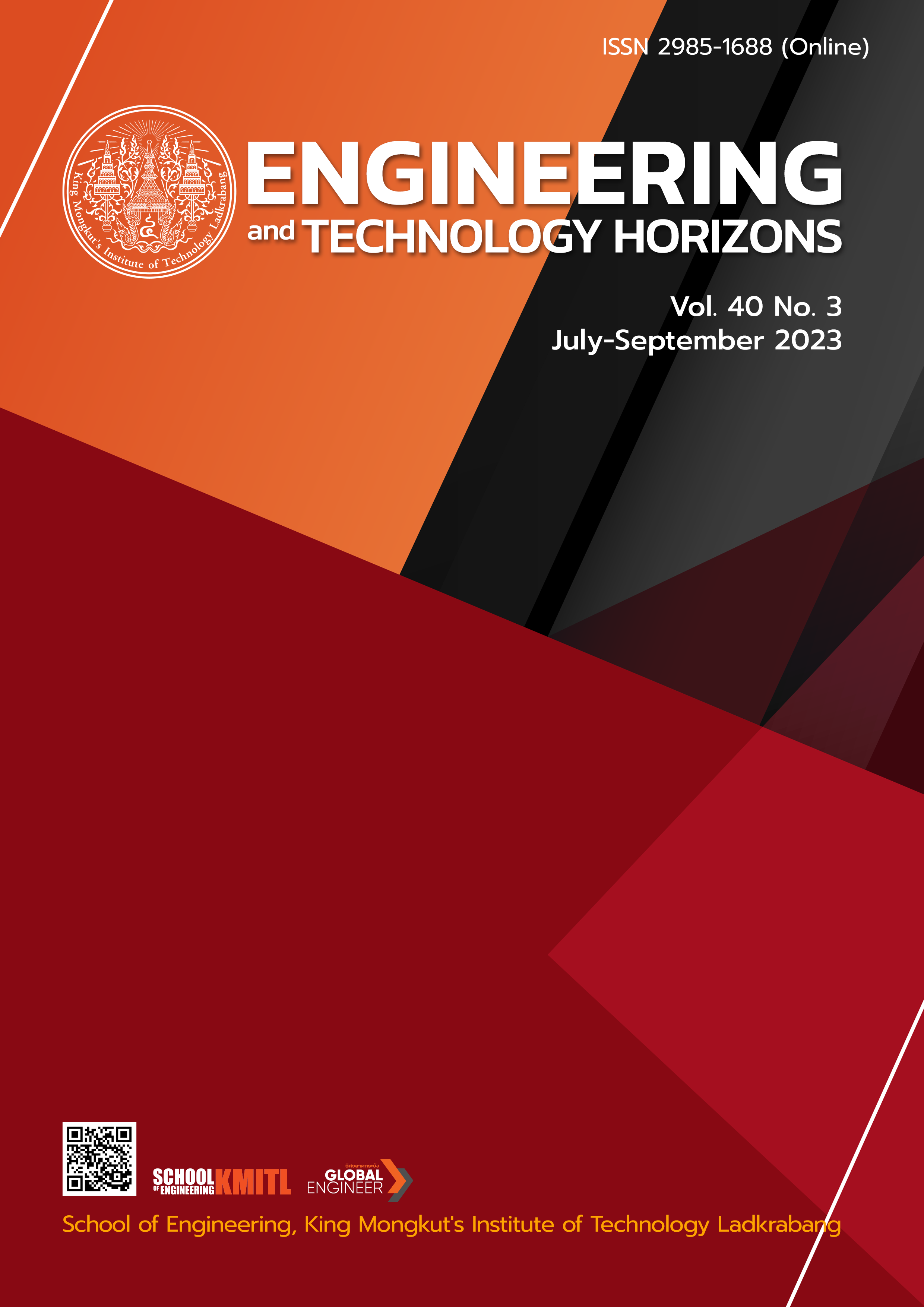The Effect of Earthquake on Temporary Structures during Bridge Construction with Different Column Heights
Keywords:
Temporary Structure, Bridge Structure, Earthquake, Nonlinear Time History AnalysisAbstract
This research aims to study the effect of earthquakes on temporary structures during bridge construction with different column heights for analysis and evaluation of the damage to temporary structures known as “Launching Gantry” and bridge structures. The primary focus is on temporary structures used in bridge construction with spans of 45 meters and heights of 7, 19, and 28 meters. The research examines four different stages of bridge construction: a single-span bridge, launching the gantry to install the next span, preparing to hang prestressed concrete box girders, and hanging the prestressed concrete box girders. The study uses 12 models created with the midas Civil computer program and nonlinear time history analysis to simulate seismic acceleration in the Bangkok area during the construction stage with a return period of 39 years to determine the internal force and the deformation. As a result, the forces were compared to the resistance according to Eurocode standards to evaluate the damage. The results show that the bridge structure is undamaged, with only minimal deformation, but significant damage was found in the legs of the supports, particularly the front support. The flexural moment and axial force were 1.53 times greater than the resistive strength, and the leg experienced deformation in the transverse direction of the bridge up to 71 millimeters, or 1/77 of the leg height.
References
L. Solazzi, “Ship to shore crane subjected to earthquake,” Procedia Engineering, vol. 10, pp. 2690–2695, 2011, doi: 10.1016/j.proeng.2011.04.448.
A. Pongsinthop and C. Chintanapakdee, “Effect of earthquakes on temporary structures while hanging segment for construction elevated structures,” in the 23rd National Convention on Civil Engineering, Nakhon Nayok, Thailand, Jul. 18–20, 2018, pp. 1–10.
Eurocode 3 - Design of steel structures - Part 1-1: General rules and rules for buildings, EN 1993-1-1:2005, European Committee for Standardisation, Brussels, Belgium, 2005.
MIDAS Information Technology Co., Ltd. midas Civil Manual – Civil structure design system, 2021. Accessed: Oct. 8, 2022. [Online]. Available:http://manual.midasuser.com/EN_Common/Civil/900/index.htm?__hstc=89262788.4b44870ec4a577029c49e44b73bd3bee.1692748800218.1692748800219.1692748800220.1&__hssc=89262788.1.1692748800221&__hsfp=954974628.
J. B. Mander, M. J. N. Priestley and R. Park, “Theoretical Stress-Strain Model for Confined Concrete,” Journal of Structural Engineering, vol. 114, no. 8, pp. 1804–1826, 1988, doi: 10.1061/(ASCE)0733-9445(1988)114:8(1804).
R. Park and T. Paulay, “Stress-Strain Relationships for Concrete and Steel” in Reinforced Concrete Structures, New York, NY, USA: John Wiley and Sons, 1973, ch. 2, pp. 11–47.
Australian Standard Bridge Design Part 4: Bearing and Deck Joints, AS 5000.4:2017, Standards Australia Committee, Sydney, Australia, 2017.
Acceleration Time History, Department of Public Works and Town & Country Planning, Bangkok, [Online]. Available: http://sites.google.com/view/dpt1302/download
Standard, Department of Public Works and Town & Country Planning, DPT 1301/1302-61, Department of Public Works and Town & Country Planning, Bangkok, Thailand, 2018.
Eurocode 8 - Design of Structures for Earthquake Resistance - Part 2: Bridges, EN 1998-2:2005, European Committee for Standardisation, Brussels, Belgium 2005.
Eurocode - Basis of structural design, EN 1990:2002, European Committee for Standardisation, Brussels, Belgium, 2002.
American Association of State Highway and Transportation Officials, “Reinforced Concrete Components,” in AASHTO Guide Specifications for LRFD Seismic Bridge Design, 2nd ed., Washington DC, USA: American Association of State Highway and Transportation Officials, 2011, ch. 8, pp. 1–49.
Structural bearings - Part 3: Elastomeric bearings, EN 1337-3:2005, European Committee for Standardisation, Brussels, Belgium, 2005.
American Association of State Highway and Transportation Officials, “Concrete Structures,” in AASHTO LRFD Bridge Design Specifications, 4th ed. Washington DC, USA: American Association of State Highway and Transportation Officials, 2007, ch. 5, pp. 99–122.
UK National Annex to Eurocode 3: Design of steel structures-Part 1-1: General rules and rules for buildings, EN 1993-1-1:2005, British Standards Institution Subcommittee, London, UK, 2008.
Specification for Structural Steel Buildings, ANSI/AISC 360-22, AISC Committee, Chicago, IL, USA, 2022.
Downloads
Published
How to Cite
Issue
Section
License
Copyright (c) 2023 Faculty of Engineering, King Mongkut’s Institute of Technology Ladkrabang

This work is licensed under a Creative Commons Attribution-NonCommercial-NoDerivatives 4.0 International License.
The published articles are copyrighted by the School of Engineering, King Mongkut's Institute of Technology Ladkrabang.
The statements contained in each article in this academic journal are the personal opinions of each author and are not related to King Mongkut's Institute of Technology Ladkrabang and other faculty members in the institute.
Responsibility for all elements of each article belongs to each author; If there are any mistakes, each author is solely responsible for his own articles.






